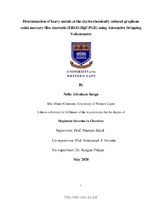| dc.contributor.advisor | Jahed, Nazeem | |
| dc.contributor.advisor | Iwuoha, Emmanuel. I. | |
| dc.contributor.advisor | Pokpas, Keagan | |
| dc.contributor.author | Sanga, Nelia Abraham | |
| dc.date.accessioned | 2020-12-09T12:18:44Z | |
| dc.date.issued | 2020 | |
| dc.identifier.uri | http://hdl.handle.net/11394/7718 | |
| dc.description | >Magister Scientiae - MSc | en_US |
| dc.description.abstract | This work reports the use of a pencil graphite electrode (PGE) as inexpensive and sensitive
electrochemical sensing platform fabricated by using electrochemically reduced graphene oxide
(ERGO) in conjunction with an in-situ plated thin mercury film. For the first time the ERGOHgF-PGE sensor is proposed for simultaneous detection of cadmium (Cd2+), copper (Cu2+), lead
(Pb2+) and zinc (Zn2+) using N-Nitroso-N-phenylhydroxylamine (cupferron) as complexing agent
by square-wave adsorptive cathodic stripping voltammetry (SW-AdCSV). The technique is
based on the adsorption of cupferron- metal ion complexes onto the surface of the ERGO-HgFPGE at 0.1 V for 60 s carried out in 0.1 M acetate buffer solution (pH 4.6). The synthesized
graphene oxide (GO) and graphene nanosheets (GNs) were characterized using different
analytical techniques such as FT-IR which confirms the presence of oxygen moieties embedded
in the graphitic structure and further demonstrated by UV-Vis, validating the synthesis of GO | en_US |
| dc.language.iso | en | en_US |
| dc.publisher | University of Western Cape | en_US |
| dc.subject | Cupferron | en_US |
| dc.subject | Graphene | en_US |
| dc.subject | Pencil graphite electrode (PGE) | en_US |
| dc.subject | Thin mercury film | en_US |
| dc.subject | Trace metal analysis | en_US |
| dc.title | Determination of heavy metals at the electrochemically reduced graphene oxide mercury film electrode (ERGO-HgF-PGE) using adsorptive stripping voltammetry | en_US |
| dc.rights.holder | University of Western Cape | en_US |
| dc.description.embargo | 2023 | |

